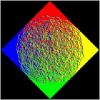So lets consider we have a light that is white 1,1,1 and red material
now reflected color is red (1,0,0)
what is the formula for that? is it just LightColor.r*materialColor.r, LightColor.g*materialColor.g, LightColor.b*materialColor.b?
maybe something more complicated,
im trying to do realistic terrain lighting, i know i will have to compute sun light intensity (probably in candles or lumens) and define material light absorption since i grass is green because it absorps red and blue light and does not use green one.










